fuel HYUNDAI ELANTRA GT 2019 Workshop Manual
[x] Cancel search | Manufacturer: HYUNDAI, Model Year: 2019, Model line: ELANTRA GT, Model: HYUNDAI ELANTRA GT 2019Pages: 486, PDF Size: 78.59 MB
Page 457 of 486
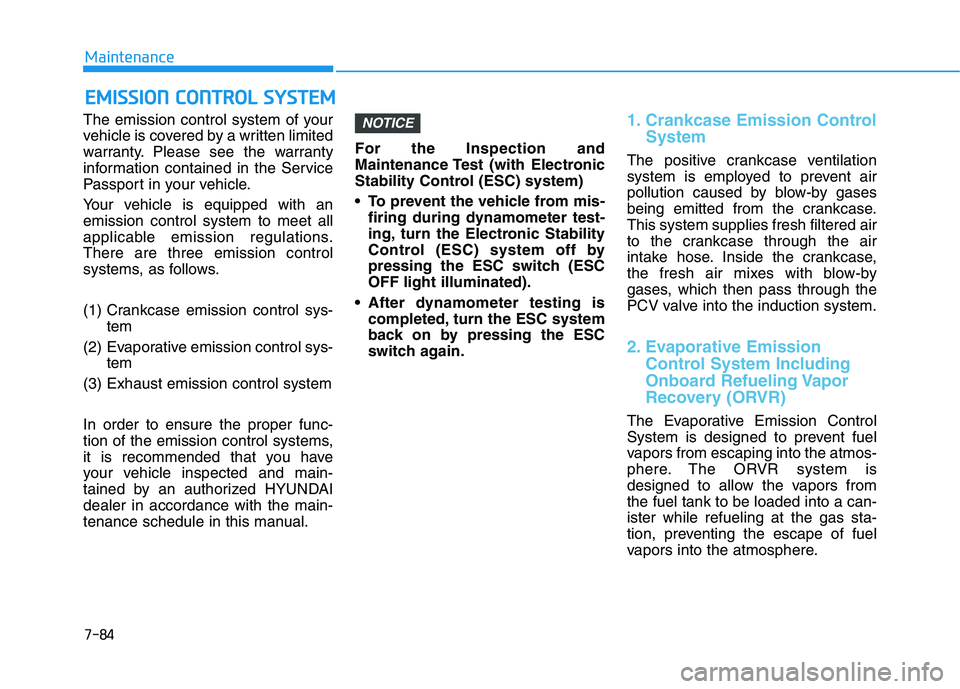
7-84
Maintenance
The emission control system of your
vehicle is covered by a written limited
warranty. Please see the warranty
information contained in the Service
Passport in your vehicle.
Your vehicle is equipped with an emission control system to meet all
applicable emission regulations.There are three emission control
systems, as follows.
(1) Crankcase emission control sys-tem
(2) Evaporative emission control sys- tem
(3) Exhaust emission control systemIn order to ensure the proper func-
tion of the emission control systems,
it is recommended that you have
your vehicle inspected and main-
tained by an authorized HYUNDAIdealer in accordance with the main-
tenance schedule in this manual. For the Inspection and
Maintenance Test (with Electronic
Stability Control (ESC) system)
To prevent the vehicle from mis-
firing during dynamometer test-
ing, turn the Electronic Stability
Control (ESC) system off by
pressing the ESC switch (ESCOFF light illuminated).
After dynamometer testing is completed, turn the ESC system
back on by pressing the ESC
switch again.1. Crankcase Emission Control
System
The positive crankcase ventilation
system is employed to prevent air
pollution caused by blow-by gases
being emitted from the crankcase.This system supplies fresh filtered air
to the crankcase through the air
intake hose. Inside the crankcase,
the fresh air mixes with blow-by
gases, which then pass through the
PCV valve into the induction system.
2. Evaporative EmissionControl System Including
Onboard Refueling Vapor
Recovery (ORVR)
The Evaporative Emission Control
System is designed to prevent fuel
vapors from escaping into the atmos-
phere. The ORVR system is
designed to allow the vapors fromthe fuel tank to be loaded into a can-ister while refueling at the gas sta-
tion, preventing the escape of fuel
vapors into the atmosphere.
NOTICE
EEMM IISS SSIIOO NN CC OO NNTTRR OO LL SS YY SSTT EEMM
Page 458 of 486
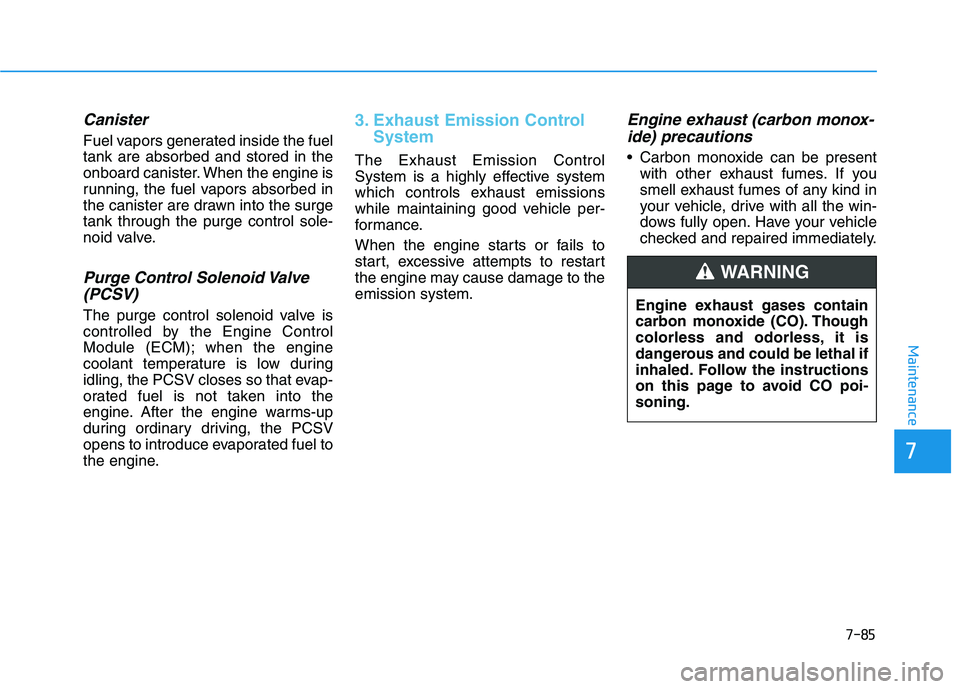
7-85
7
Maintenance
Canister
Fuel vapors generated inside the fuel tank are absorbed and stored in the
onboard canister. When the engine is
running, the fuel vapors absorbed in
the canister are drawn into the surgetank through the purge control sole-
noid valve.
Purge Control Solenoid Valve(PCSV)
The purge control solenoid valve is
controlled by the Engine Control
Module (ECM); when the engine
coolant temperature is low during
idling, the PCSV closes so that evap-
orated fuel is not taken into the
engine. After the engine warms-up
during ordinary driving, the PCSV
opens to introduce evaporated fuel to
the engine.
3. Exhaust Emission Control System
The Exhaust Emission Control
System is a highly effective system
which controls exhaust emissions
while maintaining good vehicle per-
formance.
When the engine starts or fails to
start, excessive attempts to restart
the engine may cause damage to theemission system.
Engine exhaust (carbon monox-
ide) precautions
Carbon monoxide can be present with other exhaust fumes. If you
smell exhaust fumes of any kind in
your vehicle, drive with all the win-
dows fully open. Have your vehicle
checked and repaired immediately.
Engine exhaust gases contain
carbon monoxide (CO). Though
colorless and odorless, it is
dangerous and could be lethal if
inhaled. Follow the instructions
on this page to avoid CO poi-soning.
WARNING
Page 459 of 486
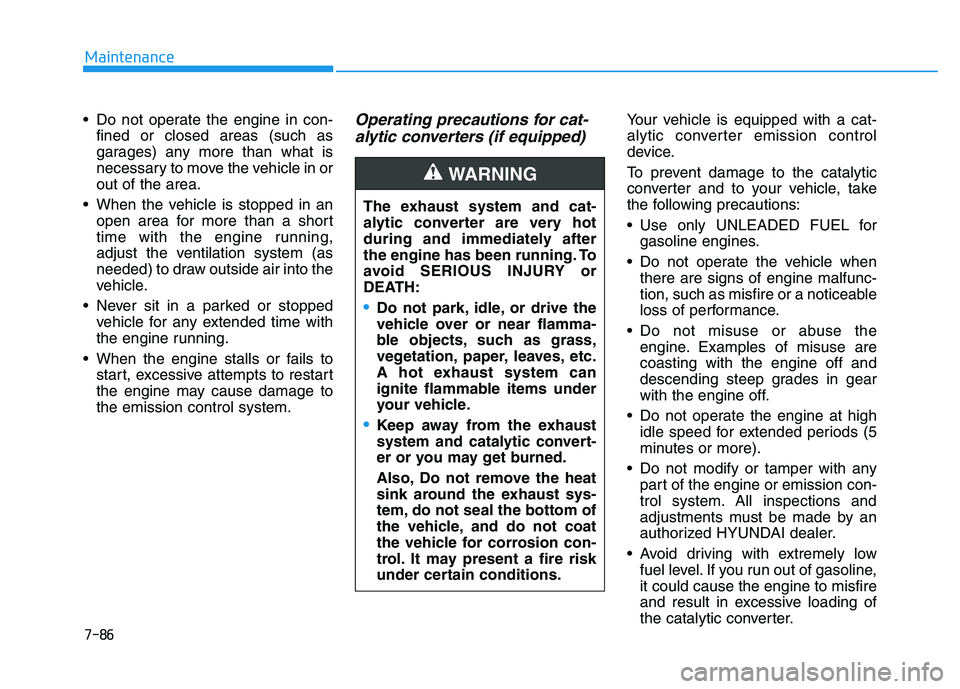
Do not operate the engine in con-fined or closed areas (such as
garages) any more than what is
necessary to move the vehicle in orout of the area.
When the vehicle is stopped in an open area for more than a short
time with the engine running,
adjust the ventilation system (as
needed) to draw outside air into the
vehicle.
Never sit in a parked or stopped vehicle for any extended time with
the engine running.
When the engine stalls or fails to start, excessive attempts to restart
the engine may cause damage tothe emission control system.Operating precautions for cat-
alytic converters (if equipped)Your vehicle is equipped with a cat-
alytic converter emission control
device.
To prevent damage to the catalytic
converter and to your vehicle, take
the following precautions:
Use only UNLEADED FUEL for gasoline engines.
Do not operate the vehicle when there are signs of engine malfunc-
tion, such as misfire or a noticeable
loss of performance.
Do not misuse or abuse the engine. Examples of misuse arecoasting with the engine off and
descending steep grades in gear
with the engine off.
Do not operate the engine at high idle speed for extended periods (5
minutes or more).
Do not modify or tamper with any part of the engine or emission con-
trol system. All inspections and
adjustments must be made by an
authorized HYUNDAI dealer.
Avoid driving with extremely low fuel level. If you run out of gasoline,it could cause the engine to misfire
and result in excessive loading of
the catalytic converter.
The exhaust system and cat-
alytic converter are very hot
during and immediately after
the engine has been running. To
avoid SERIOUS INJURY or
DEATH:
Do not park, idle, or drive the
vehicle over or near flamma-
ble objects, such as grass,
vegetation, paper, leaves, etc.
A hot exhaust system can
ignite flammable items under
your vehicle.
Keep away from the exhaust
system and catalytic convert-
er or you may get burned.
Also, Do not remove the heat
sink around the exhaust sys-
tem, do not seal the bottom of
the vehicle, and do not coat
the vehicle for corrosion con-
trol. It may present a fire risk
under certain conditions.
WARNING
Maintenance
7-86
Page 467 of 486
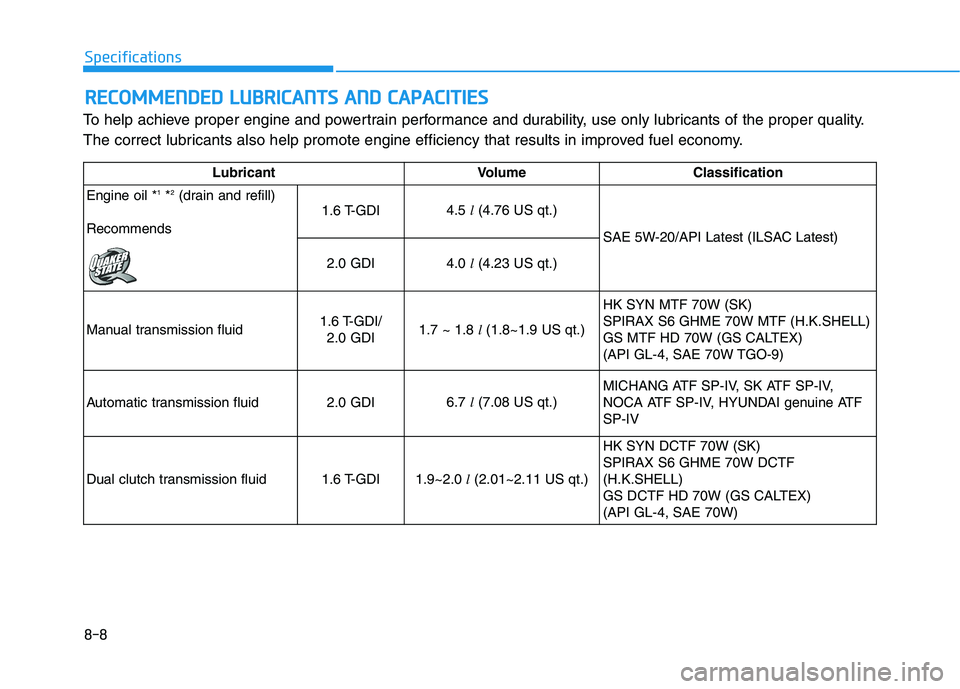
8-8
Specifications
To help achieve proper engine and powertrain performance and durability, use only lubricants of the proper quality.
The correct lubricants also help promote engine efficiency that results in improved fuel economy.
RREECCOO MM MMEENN DDEEDD LL UU BBRRIICC AA NN TTSS AA NN DD CC AA PPAA CCIITT IIEE SS
LubricantVolume Classification
Engine oil * 1
*2
(drain and refill)
Recommends
1.6 T-GDI4.5 l(4.76 US qt.)
SAE 5W-20/API Latest (ILSAC Latest)
2.0 GDI4.0 l(4.23 US qt.)
Manual transmission fluid
1.6 T-GDI/ 2.0 GDI1.7 ~ 1.8 l(1.8~1.9 US qt.) HK SYN MTF 70W (SK) SPIRAX S6 GHME 70W MTF (H.K.SHELL)
GS MTF HD 70W (GS CALTEX)
(API GL-4, SAE 70W TGO-9)
Automatic transmission fluid2.0 GDI6.7
l(7.08 US qt.)
MICHANG ATF SP-IV, SK ATF SP-IV,
NOCA ATF SP-IV, HYUNDAI genuine ATFSP-IV
Dual clutch transmission fluid1.6 T-GDI1.9~2.0 l(2.01~2.11 US qt.)
HK SYN DCTF 70W (SK) SPIRAX S6 GHME 70W DCTF(H.K.SHELL)
GS DCTF HD 70W (GS CALTEX)(API GL-4, SAE 70W)
Page 468 of 486
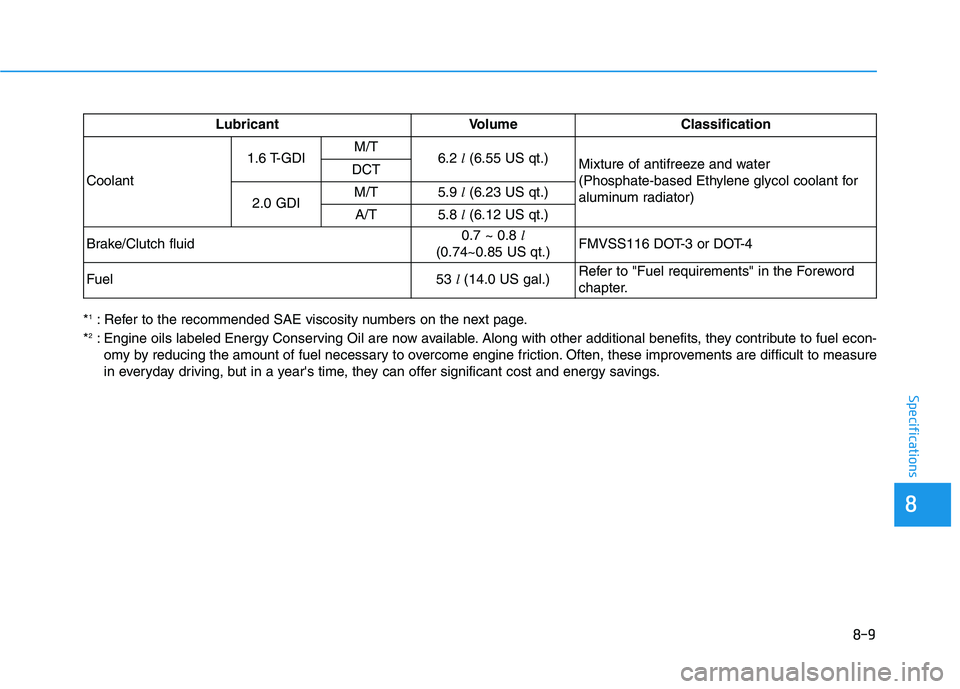
8-9
88
Specifications
*1
: Refer to the recommended SAE viscosity numbers on the next page.
* 2
: Engine oils labeled Energy Conserving Oil are now available. Along with other additional benefits, they contribute to fuel econ -
omy by reducing the amount of fuel necessary to overcome engine friction. Often, these improvements are difficult to measure
in everyday driving, but in a year's time, they can offer significant cost and energy savings. Lubricant
Volume Classification
Coolant 1.6 T-GDI
M/T
6.2
l(6.55 US qt.)
Mixture of antifreeze and water
(Phosphate-based Ethylene glycol coolant for
aluminum radiator)
DCT
2.0 GDI M/T
5.9
l(6.23 US qt.)
A/T
5.8 l(6.12 US qt.)
Brake/Clutch fluid
0.7 ~ 0.8 l
(0.74~0.85 US qt.) FMVSS116 DOT-3 or DOT-4
Fuel53
l(14.0 US gal.)Refer to "Fuel requirements" in the Foreword
chapter.
Page 469 of 486
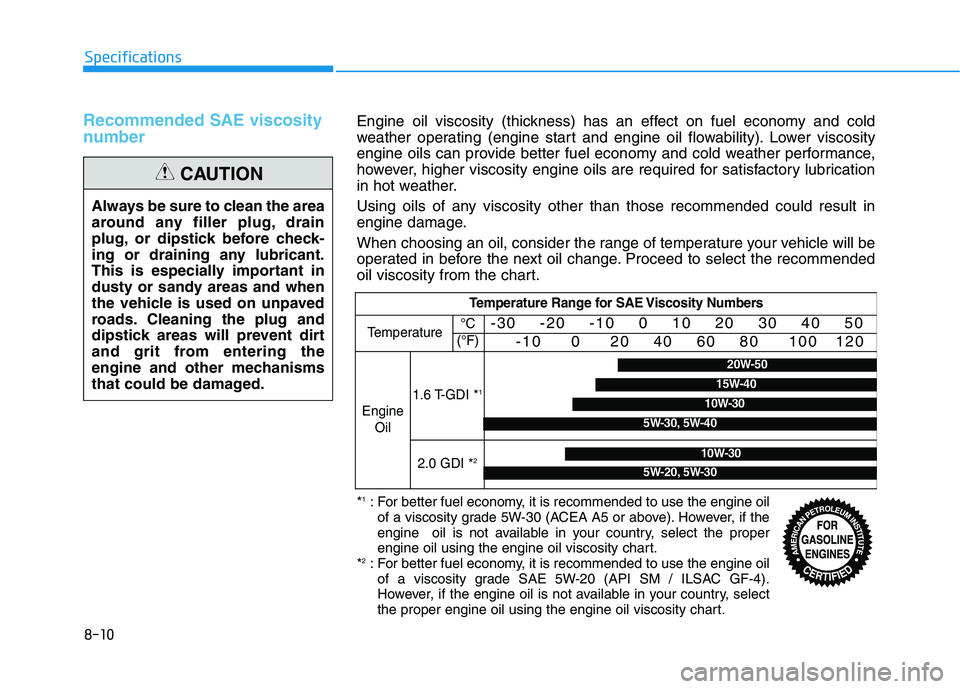
8-10
Specifications
Recommended SAE viscosity
number
Always be sure to clean the area
around any filler plug, drain
plug, or dipstick before check-
ing or draining any lubricant.
This is especially important in
dusty or sandy areas and when
the vehicle is used on unpaved
roads. Cleaning the plug and
dipstick areas will prevent dirt
and grit from entering the
engine and other mechanisms
that could be damaged.
CAUTION
Temperature Range for SAE Viscosity Numbers
Temperature -30 -20 -10 0 10 20 30 40 50
-10 0 20 40 60 80 100 120
Engine Oil
1.6 T-GDI * 1
2.0 GDI *2
°C
(°F)
* 1
: For better fuel economy, it is recommended to use the engine oil
of a viscosity grade 5W-30 (ACEA A5 or above). However, if the
engine oil is not available in your country, select the proper
engine oil using the engine oil viscosity chart.
* 2
: For better fuel economy, it is recommended to use the engine oil
of a viscosity grade SAE 5W-20 (API SM / ILSAC GF-4).
However, if the engine oil is not available in your country, select
the proper engine oil using the engine oil viscosity chart.
5W-30, 5W-40
10W-30
15W-40
20W-50
10W-30
5W-20, 5W-30
Engine oil viscosity (thickness) has an effect on fuel economy and cold
weather operating (engine start and engine oil flowability). Lower viscosity
engine oils can provide better fuel economy and cold weather performance,
however, higher viscosity engine oils are required for satisfactory lubrication
in hot weather.
Using oils of any viscosity other than those recommended could result in
engine damage.
When choosing an oil, consider the range of temperature your vehicle will be
operated in before the next oil change. Proceed to select the recommended
oil viscosity from the chart.
Page 477 of 486
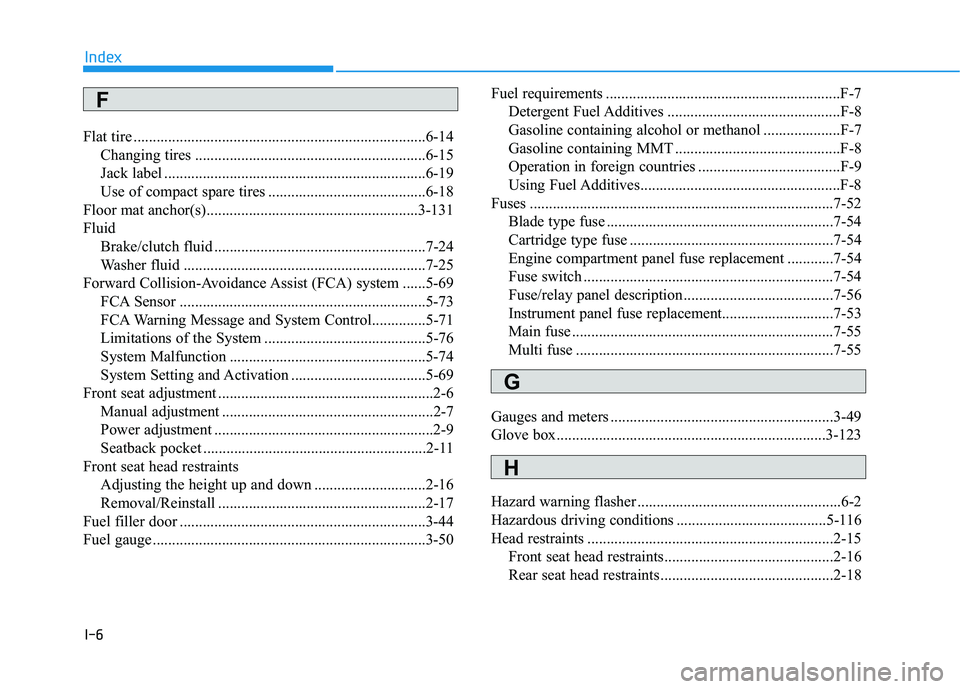
I-6
Flat tire ............................................................................6-14
Changing tires ............................................................6-15
Jack label ....................................................................6-19
Use of compact spare tires .........................................6-18
Floor mat anchor(s).......................................................3-131
Fluid Brake/clutch fluid .......................................................7-24
Washer fluid ...............................................................7-25
Forward Collision-Avoidance Assist (FCA) system ......5-69 FCA Sensor ................................................................5-73
FCA Warning Message and System Control..............5-71
Limitations of the System ..........................................5-76
System Malfunction ...................................................5-74
System Setting and Activation ...................................5-69
Front seat adjustment ........................................................2-6 Manual adjustment .......................................................2-7
Power adjustment .........................................................2-9
Seatback pocket ..........................................................2-11
Front seat head restraints Adjusting the height up and down .............................2-16
Removal/Reinstall ......................................................2-17
Fuel filler door ................................................................3-44
Fuel gauge .......................................................................3-50 Fuel requirements .............................................................F-7
Detergent Fuel Additives .............................................F-8
Gasoline containing alcohol or methanol ....................F-7
Gasoline containing MMT ...........................................F-8
Operation in foreign countries .....................................F-9
Using Fuel Additives....................................................F-8
Fuses ...............................................................................7-52 Blade type fuse ...........................................................7-54
Cartridge type fuse .....................................................7-54
Engine compartment panel fuse replacement ............7-54
Fuse switch .................................................................7-54
Fuse/relay panel description .......................................7-56
Instrument panel fuse replacement.............................7-53
Main fuse ....................................................................7-55
Multi fuse ...................................................................7-55
Gauges and meters ..........................................................3-49
Glove box......................................................................3-123
Hazard warning flasher .....................................................6-2
Hazardous driving conditions .......................................5-116
Head restraints ................................................................2-15 Front seat head restraints............................................2-16
Rear seat head restraints .............................................2-18
Index
F
G
H
Page 479 of 486
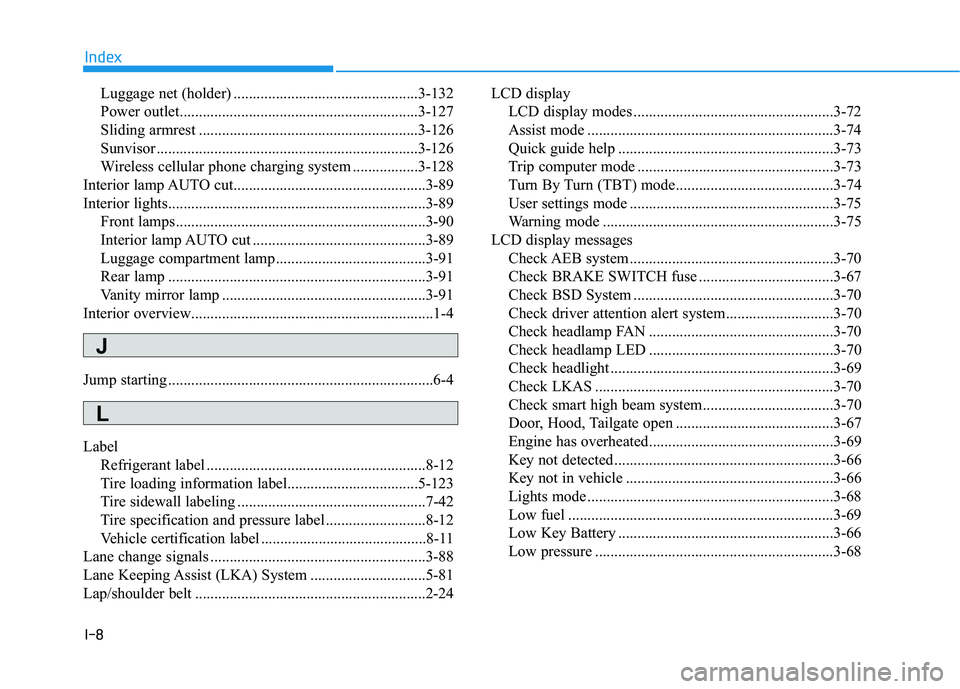
I-8Luggage net (holder) ................................................3-132
Power outlet..............................................................3-127
Sliding armrest .........................................................3-126
Sunvisor ....................................................................3-126
Wireless cellular phone charging system .................3-128
Interior lamp AUTO cut..................................................3-89
Interior lights...................................................................3-89 Front lamps.................................................................3-90
Interior lamp AUTO cut .............................................3-89
Luggage compartment lamp .......................................3-91
Rear lamp ...................................................................3-91
Vanity mirror lamp .....................................................3-91
Interior overview...............................................................1-4
Jump starting .....................................................................6-4
Label
Refrigerant label .........................................................8-12
Tire loading information label..................................5-123
Tire sidewall labeling .................................................7-42
Tire specification and pressure label ..........................8-12
Vehicle certification label ...........................................8-11
Lane change signals ........................................................3-88
Lane Keeping Assist (LKA) System ..............................5-81
Lap/shoulder belt ............................................................2-24 LCD display
LCD display modes ....................................................3-72
Assist mode ................................................................3-74
Quick guide help ........................................................3-73
Trip computer mode ...................................................3-73
Turn By Turn (TBT) mode.........................................3-74
User settings mode .....................................................3-75
Warning mode ............................................................3-75
LCD display messages Check AEB system .....................................................3-70
Check BRAKE SWITCH fuse ...................................3-67
Check BSD System ....................................................3-70
Check driver attention alert system............................3-70
Check headlamp FAN ................................................3-70
Check headlamp LED ................................................3-70
Check headlight ..........................................................3-69
Check LKAS ..............................................................3-70
Check smart high beam system..................................3-70
Door, Hood, Tailgate open .........................................3-67
Engine has overheated................................................3-69
Key not detected .........................................................3-66
Key not in vehicle ......................................................3-66
Lights mode ................................................................3-68
Low fuel .....................................................................3-69
Low Key Battery ........................................................3-66
Low pressure ..............................................................3-68
Index
J
L
Page 484 of 486
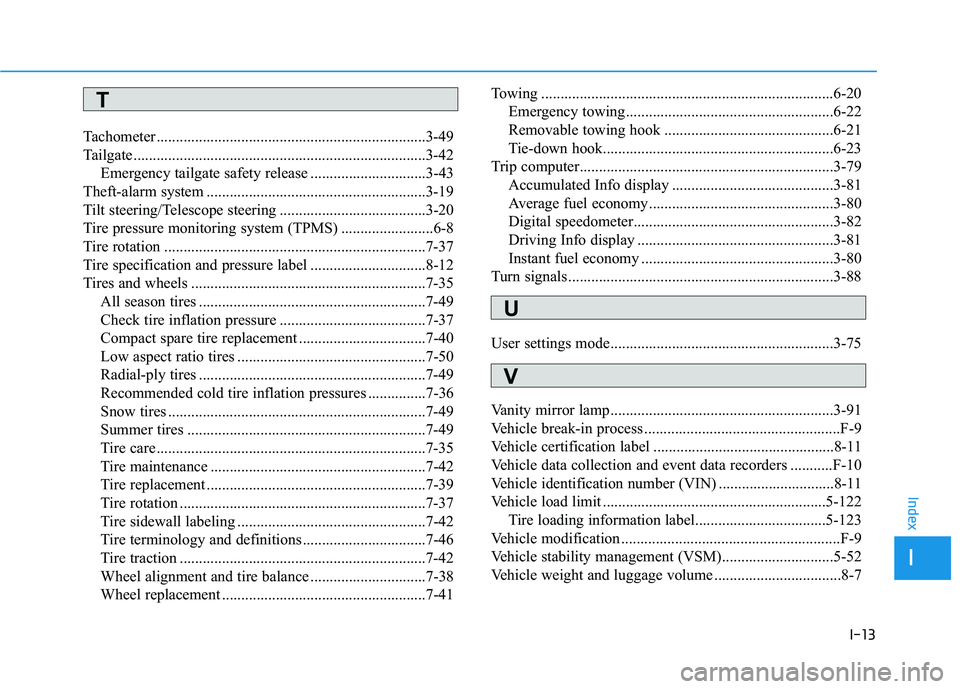
I-13
Tachometer ......................................................................3-49
Tailgate ............................................................................3-42
Emergency tailgate safety release ..............................3-43
Theft-alarm system .........................................................3-19
Tilt steering/Telescope steering ......................................3-20
Tire pressure monitoring system (TPMS) ........................6-8
Tire rotation ....................................................................7-37
Tire specification and pressure label ..............................8-12
Tires and wheels .............................................................7-35 All season tires ...........................................................7-49
Check tire inflation pressure ......................................7-37
Compact spare tire replacement .................................7-40
Low aspect ratio tires .................................................7-50
Radial-ply tires ...........................................................7-49
Recommended cold tire inflation pressures ...............7-36
Snow tires ...................................................................7-49
Summer tires ..............................................................7-49
Tire care ......................................................................7-35
Tire maintenance ........................................................7-42
Tire replacement .........................................................7-39
Tire rotation ................................................................7-37
Tire sidewall labeling .................................................7-42
Tire terminology and definitions ................................7-46
Tire traction ................................................................7-42
Wheel alignment and tire balance ..............................7-38
Wheel replacement .....................................................7-41 Towing ............................................................................6-20
Emergency towing......................................................6-22
Removable towing hook ............................................6-21
Tie-down hook............................................................6-23
Trip computer..................................................................3-79 Accumulated Info display ..........................................3-81
Average fuel economy................................................3-80
Digital speedometer....................................................3-82
Driving Info display ...................................................3-81
Instant fuel economy ..................................................3-80
Turn signals.....................................................................3-88
User settings mode..........................................................3-75
Vanity mirror lamp..........................................................3-91
Vehicle break-in process ...................................................F-9
Vehicle certification label ...............................................8-11
Vehicle data collection and event data recorders ...........F-10
Vehicle identification number (VIN) ..............................8-11
Vehicle load limit ..........................................................5-122 Tire loading information label..................................5-123
Vehicle modification .........................................................F-9
Vehicle stability management (VSM).............................5-52
Vehicle weight and luggage volume .................................8-7
I
Index
T
U
V
Page 485 of 486
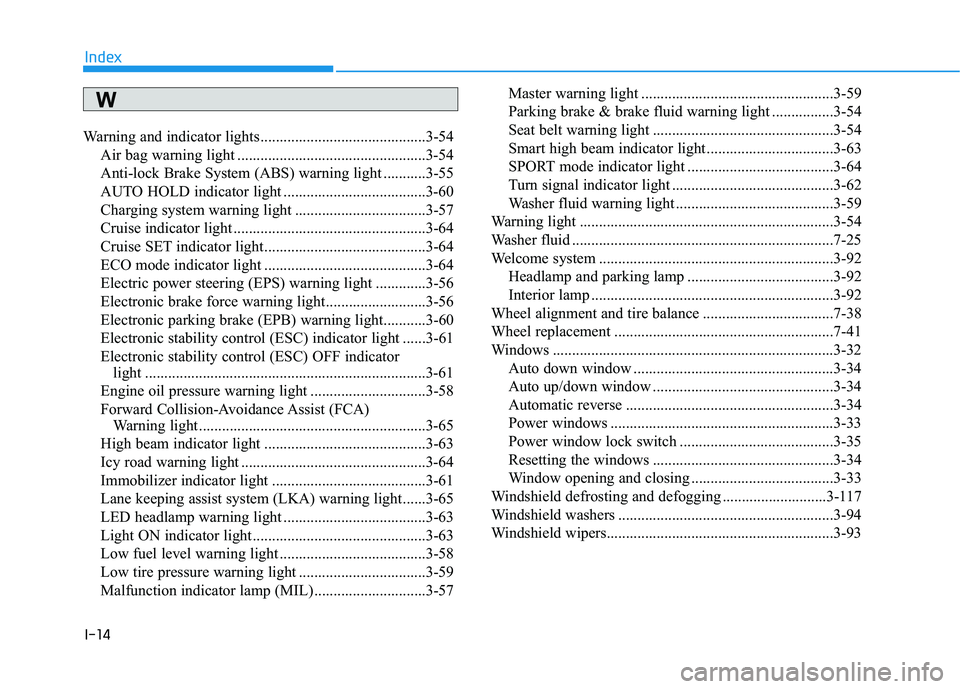
I-14
Warning and indicator lights...........................................3-54
Air bag warning light .................................................3-54
Anti-lock Brake System (ABS) warning light ...........3-55
AUTO HOLD indicator light .....................................3-60
Charging system warning light ..................................3-57
Cruise indicator light ..................................................3-64
Cruise SET indicator light..........................................3-64
ECO mode indicator light ..........................................3-64
Electric power steering (EPS) warning light .............3-56
Electronic brake force warning light..........................3-56
Electronic parking brake (EPB) warning light...........3-60
Electronic stability control (ESC) indicator light ......3-61
Electronic stability control (ESC) OFF indicator light .........................................................................3-61
Engine oil pressure warning light ..............................3-58
Forward Collision-Avoidance Assist (FCA) Warning light ...........................................................3-65
High beam indicator light ..........................................3-63
Icy road warning light ................................................3-64
Immobilizer indicator light ........................................3-61
Lane keeping assist system (LKA) warning light......3-65
LED headlamp warning light .....................................3-63
Light ON indicator light .............................................3-63
Low fuel level warning light ......................................3-58
Low tire pressure warning light .................................3-59
Malfunction indicator lamp (MIL) .............................3-57 Master warning light ..................................................3-59
Parking brake & brake fluid warning light ................3-54
Seat belt warning light ...............................................3-54
Smart high beam indicator light .................................3-63
SPORT mode indicator light ......................................3-64
Turn signal indicator light ..........................................3-62
Washer fluid warning light .........................................3-59
Warning light ..................................................................3-54
Washer fluid ....................................................................7-25
Welcome system .............................................................3-92
Headlamp and parking lamp ......................................3-92
Interior lamp ...............................................................3-92
Wheel alignment and tire balance ..................................7-38
Wheel replacement .........................................................7-41
Windows .........................................................................3-32 Auto down window ....................................................3-34
Auto up/down window ...............................................3-34
Automatic reverse ......................................................3-34
Power windows ..........................................................3-33
Power window lock switch ........................................3-35
Resetting the windows ...............................................3-34
Window opening and closing .....................................3-33
Windshield defrosting and defogging ...........................3-117
Windshield washers ........................................................3-94
Windshield wipers...........................................................3-93
Index
W